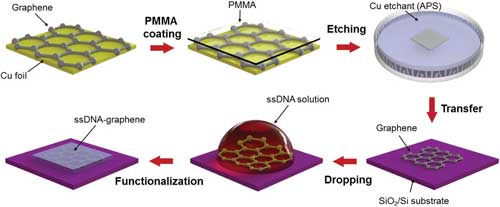| Posted: Jul 11, 2017 | |
DNA-functionalized graphene sensor for breath analysis(Nanowerk News) Reporting their findings in Advanced Functional Materials ("Humidity-Tolerant Single-Stranded DNA-Functionalized Graphene Probe for Medical Applications of Exhaled Breath Analysis"), researchers in Korea have demonstrated the enhanced sensing ability in a high humidity atmosphere of graphene sensors functionalized by single-stranded DNA, and proposed their novel sensing mechanism. |
|
| The device was constructed in a cost-effective manner by incubating graphene sensor platforms in droplets of the ssDNA solution, where ssDNA molecules were immobilized on top of the graphene via π-π stacking interaction. | |
 |
|
| Schematic illustration of the synthetic process for functionalizing graphene on an SiO2/Si substrate with ssDNA molecules. (© Wiley-VCH Verlag) (click on image to enlarge) | |
| The team investigated the modulation of carrier density in the active graphene channel via electrostatic interaction with overlaying ssDNAs. They found that the single-stranded DNA-functionalized graphene (ssDNA-FG) sensors exhibit highly sensitive responses for amonia (NH3) and hydrogen sulfide (H2S) vapors, with the low detection limit of 103 ppb and 5.3 ppb, respectively, in a high relative humidity atmosphere. | |
| These results show that the enhanced sensing ability is attributed to the effective modulation of not only the carrier density in graphene through negative-potential gating, but also the formation of an additional ion conduction path for proton hopping in the layer of H3O+ around ssDNA molecules. | |
| By using principal component analysis (PCA), the researchers showed that ssDNA-FG sensor arrays can distinguish the halitosis and kidney disorder cancer related biomarkers, H2S and NH3 vapors, respectively. | |
| Although this study is at a rather fundamental level, by focusing on simple cases of combinations of graphene and ssDNA molecules, the scientists succeeded in effectively demonstrating enhanced chemical vapor sensing at high humidity. | |
| "Considering its selective vapor sensing capability in a high humidity condition, we expect that ssDNA-FG will provide a promising sensing platform for an inexpensive and noninvasive diagnostic tool to monitor halitosis and kidney disorder," the authors conclude their report.. |
 By
Michael
Berger
– Michael is author of three books by the Royal Society of Chemistry:
Nano-Society: Pushing the Boundaries of Technology,
Nanotechnology: The Future is Tiny, and
Nanoengineering: The Skills and Tools Making Technology Invisible
Copyright ©
Nanowerk LLC
By
Michael
Berger
– Michael is author of three books by the Royal Society of Chemistry:
Nano-Society: Pushing the Boundaries of Technology,
Nanotechnology: The Future is Tiny, and
Nanoengineering: The Skills and Tools Making Technology Invisible
Copyright ©
Nanowerk LLC
|
|
|
Subscribe to a free copy of one of our daily Nanowerk Newsletter Email Digests with a compilation of all of the day's news. |
